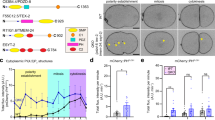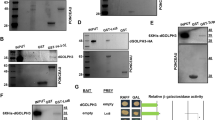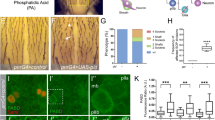Abstract
During early embryogenesis in Drosophila melanogaster, extensive vesicle transport occurs to build cell boundaries for 6,000 nuclei. Here we show that this important process depends on a functional complex formed between the tumour suppressor and adaptor protein Discs-Large (Dlg)1 and the integral membrane protein Strabismus (Stbm)/Van Gogh (Vang)2,3. In support of this idea, embryos with mutations in either dlg or stbm displayed severe defects in plasma membrane formation. Conversely, overexpression of Dlg and Stbm synergistically induced excessive plasma membrane formation. In addition, ectopic co-expression of Stbm (which associated with post-Golgi vesicles) and the mammalian Dlg homologue SAP97/hDlg4,5 promoted translocation of SAP97 from the cytoplasm to both post-Golgi vesicles and the plasma membrane. This effect was dependent on the interaction between Stbm and SAP97. These findings suggest that the Dlg–Stbm complex recruits membrane-associated proteins and lipids from internal membranes to sites of new plasma membrane formation.
This is a preview of subscription content, access via your institution
Access options
Subscribe to this journal
Receive 12 print issues and online access
$209.00 per year
only $17.42 per issue
Buy this article
- Purchase on Springer Link
- Instant access to full article PDF
Prices may be subject to local taxes which are calculated during checkout





Similar content being viewed by others
References
Woods, D.F. & Bryant, P.J. The discs-large tumor suppressor gene of Drosophila encodes a guanylate kinase homolog localized at septate junctions. Cell 66, 451–464 (1991).
Wolff, T. & Rubin, G.R. strabismus, a novel gene that regulates tissue polarity and cell fate decisions in Drosophila. Development 125, 1149–1159 (1998).
Taylor, J., Abramova, N., Charlton, J. & Adler P.N. Van Gogh: A new Drosophila tissue polarity gene. Genetics 150, 199–210 (1998).
Lue, R.A., Marfatia, S.M., Branton, D. & Chishti, A.H. Cloning and characterization of hDLG: the human homologue of the Drosophila discs large tumor suppressor binds to protein 4.1. Proc. Natl Acad. Sci. USA 91, 9818–9822 (1994).
Muller, B.M. et al. Molecular characterization and spatial distribution of SAP97, a novel presynaptic protein homologous to SAP90 and the Drosophila discs-large tumor suppressor protein. J. Neurosci. 15, 2354–2366 (1995).
Foe, V.E., Odell, G.M. & Edgar, B.A in The Development of Drosophila melanogaster (eds Bate, M. & Martinez-Ariaz, A.) 149–300 (Cold Spring Harbor Laboratory Press, Cold Spring Harbor, 1993).
Lecuit, T. & Wieschaus, E. Polarized insertion of new membrane from a cytoplasmic reservoir during cleavage of the Drosophila embryos. J. Cell Biol. 150, 849–860 (2000).
Bilder, D. PDZ proteins and polarity: functions from the fly. Trends Genet. 17, 511–519 (1991).
Rao, A., Kim, E., Sheng, M. & Craig, A.M. Heterogeneity in the molecular composition of excitatory postsynaptic sites during development of hippocampal neurons in culture. J. Neurosci. 18, 1217–1229 (1998).
Thomas U. et al. Synaptic targeting and localization of discs-large is a stepwise process controlled by different domains of the protein. Curr. Biol. 10, 1108–1117 (2000).
El-Husseini A.E. et al. Dual palmitoylation of PSD-95 mediates its vesiculotubular sorting, postsynaptic targeting, and ion channel clustering. J. Cell Biol. 148, 159–172 (2000).
Sans N. et al. Synapse-associated protein 97 selectively associates with a subset of AMPA receptors early in their biosynthetic pathway. J. Neurosci. 21, 7506–7516 (2001).
Kibar Z. et al. Ltap, a mammalian homolog of Drosophila Strabismus/Van Gogh, is altered in the mouse neural tube mutant Loop-tail. Nature Genet. 28, 251–255 (2001).
Jessen J.R. et al. Zebrafish trilobite identifies new roles for Strabismus in gastrulation and neuronal movements. Nature Cell Biol. 4, 610–615 (2002).
Mendoza, C. et al. Novel isoforms of Dlg are fundamental for neuronal development in Drosophila. J. Neurosci. 23, 2093–2101 (2003).
Bhat M.A. et al. Discs Lost, a novel multi-PDZ domain protein, establishes and maintains epithelial polarity. Cell 96, 833–845 (1999).
Burgess, R.W., Deitcher, D.L. & Schwarz, T.L. The synaptic protein Syntaxin1 is required for cellularization of Drosophila embryos. J. Cell Biol. 138, 861–875 (1997).
Chetkovich, D.M. et al. Postsynaptic targeting of alternative Postsynaptic density-95 isoforms by distinct mechanisms. J. Neurosci. 22, 6415–6425 (2002).
Nakamura, N. et al. Characterization of a cis-Golgi matrix protein, GM130. J. Cell Biol. 131, 1715–1726 (1995).
Kondylis, V., Goulding, S.E., Dunne, J.C. & Rabouille, C. Biogenesis of Golgi stacks in imaginal discs of Drosphila melanogaster. Mol. Biol. Cell 12, 2308–2327 (2001).
Stanley, H., Botas, J. & Malhotra, V. The mechanism of Golgi segregation during mitosis is cell type-specific. Proc. Natl Acad. Sci. USA 94, 14467–14470 (1997).
Lucocq, J.M. & Warren, G. Fragmentation and partitioning of the Golgi apparatus during mitosis in HeLa cells. EMBO J. 6, 3239–3246 (1987).
Cole, N.B. et al. Golgi dispersal during a microtubule disruption-regeneration of Golgi stacks at peripheral endoplasmic-reticulum exit sites. Mol. Biol. Cell 7, 631–650 (1996).
Baumgartner, S. et al. A Drosophila neurexin is required for septate junction and blood-nerve barrier formation and function. Cell 87, 1059–1068 (1996).
Perrimon, N. The maternal effect of lethal(1)discs-large-1: a recessive oncogene of Drosophila melanogaster. Dev. Biol. 127, 382–407 (1988).
Strutt, D., Johnson, R., Cooper, K., & Bray, S. Asymmetric localization of frizzled and the determination of notch-dependent cell fate in the Drosophila eye. Curr. Biol. 12, 813–824 (2002).
Rawls, A.S. & Wolff, T. Strabismus requires Flamingo and Prickle function to regulate tissue polarity in the Drosophila eye. Development 130, 1877–1887 (2003).
Bastock, R., Strutt, H., & Strutt, D. Strabismus is asymmetrically localized and binds to Prickle and Dishevelled during Drosophila planar polarity patterning. Development 130, 3007–3014 (2003).
Tepass, U., Tanentzapf, G., Ward, R. & Fehon, R. Epithelial cell polarity and cell junctions in Drosophila. Annu. Rev. Genet. 35, 747–784 (2001).
Bilder, D., Li, M. & Perrimon, N. Cooperative regulation of cell polarity and growth by Drosophila tumor suppressors. Science 289, 113–116 (2002).
Fujita Y. et al. Tomosyn: a syntaxin-1-binding protein that forms a novel complex in the neurotransmitter release process. Neuron 20, 905–915 (1998).
Lehman, K., Rossi, G., Adamo, J.E. & Brenwald, P. Yeast homologues of Tomosyn and lethal giant larvae function in exocytosis and are associated with the plasma membrane SNARE, sec9. J. Cell Biol. 146, 125–140 (1999).
Murdoch, J.N. et al. Disruption of scribble (Scrb1) causes severe neural tube defects in the circletail mouse. Hum. Mol. Genet. 12, 87–98 (2003).
Sans, N. et al. NMDA receptor trafficking through an interaction between PDZ proteins and the exocyst complex. Nature Cell Biol. 5, 520–530 (2003).
Novick, P. & Guo, W. Ras family therapy: Rab, Rho and Ral talk to the exocyst. Trends Cell Biol. 12, 247–249 (2002).
Durfee, T. et al. The retinoblastoma protein associates with the protein phosphatase type 1 catalytic subunit. Genes Dev. 7, 555–569 (1993).
Weiss, R.S., McArthur, M.J., & Javier, R.T. Human adenovirus type 9 E4 open reading frame 1 encodes a cytoplasmic transforming protein capable of increasing the oncogenicity of CREF cells. J. Virol. 70, 862–872 (1996).
Acknowledgements
We thank M. Kuroda, R. Kelley, S. Izaddoost, and K.-W. Choi for valuable discussions, T. Wolff for stbm mutants and stbm cDNA, P. Bryant for dlg mutants and guinea pig anti-Dlg antibody, S. Ou and P. Patterson for generating anti-Stbm antibody, M. Lowe for anti-GM130 antibody, S. Elledge for two-hybrid system reagents, H. Bellen for Hrs and Nrx antibodies, and the Bloomington Stock Center for fly strains. K.K.F. was the recipient of the Viral Oncology Training Grant predoctoral fellowship T32 CA009197. R.T.J. and K.-O.C. were supported by National Institutes of Health grants RO1 CA058541 and R29 NS35532, respectively.
Author information
Authors and Affiliations
Corresponding author
Ethics declarations
Competing interests
The authors declare no competing financial interests.
Supplementary information
Supplementary Information, Fig. S1
Supplementary Information, Fig. S2 (PDF 1263 kb)
Supplementary Information, Fig. S3
Supplementary Information, Fig. S4
Rights and permissions
About this article
Cite this article
Lee, OK., Frese, K., James, J. et al. Discs-Large and Strabismus are functionally linked to plasma membrane formation. Nat Cell Biol 5, 987–993 (2003). https://doi.org/10.1038/ncb1055
Received:
Accepted:
Published:
Issue Date:
DOI: https://doi.org/10.1038/ncb1055
This article is cited by
-
The PCP pathway regulates Baz planar distribution in epithelial cells
Scientific Reports (2016)
-
PDZ interaction of Vangl2 links PSD-95 and Prickle2 but plays only a limited role in the synaptic localisation of Vangl2
Scientific Reports (2015)
-
Role of Rab11 in planar cell polarity and apical constriction during vertebrate neural tube closure
Nature Communications (2014)
-
Upsides and downsides to polarity and asymmetric cell division in leukemia
Oncogene (2008)
-
Cell polarity proteins: common targets for tumorigenic human viruses
Oncogene (2008)



